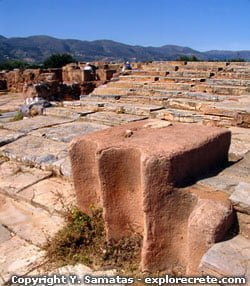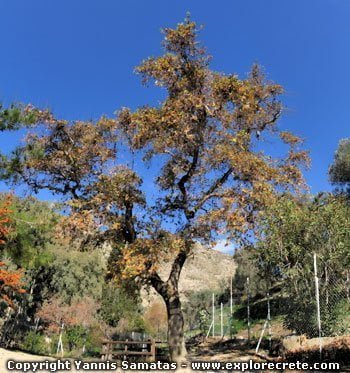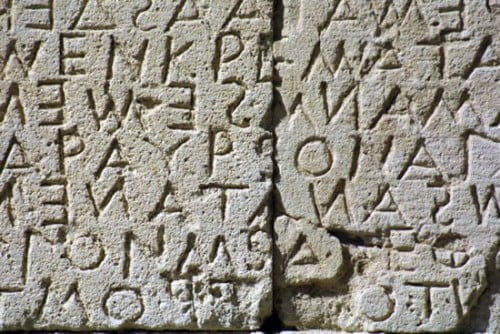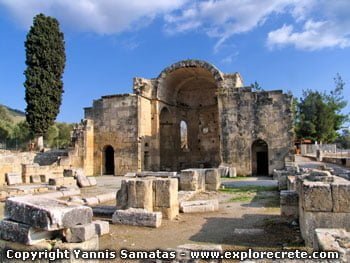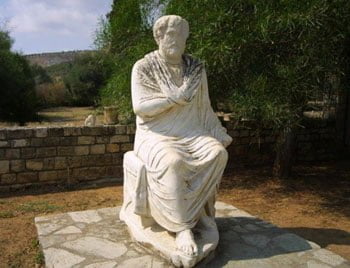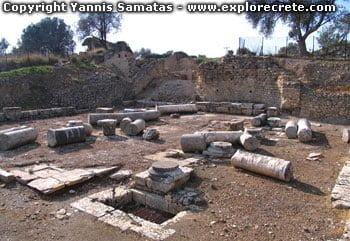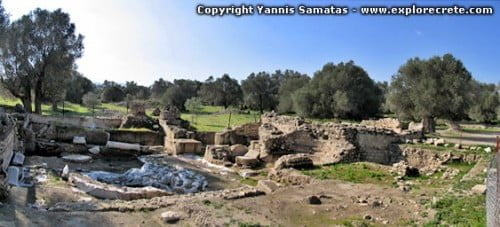Malia Palace
The Minoan Palace of Malia
The Minoan Palace of Malia is located east of the homonym town in Crete. This is the third-largest Minoan palace in Crete, built in a wonderful setting near the sea, on the road linking the eastern and central part of the island.
Malia palace – the seat, according to myth, of Minos’ brother Sarpedon – was first constructed circa 1900 BC. The already large settlement, some parts of which are preserved around the palace, thus became a palace-city. This first palace was destroyed circa 1700 BC and rebuilt circa 1650 BC, on the same site and with the same layout. Finally the new palace was destroyed circa 1450 BC and not reoccupied. During the Mycenean period a small building, probably a sanctuary, was constructed in the ruins.
At Malia we can actually walk around the actual palace, just as it was uncovered by archaeological excavations. Most of the ruins visible today belong to the Neopalatial complex – the second palace – whose rooms are set around three courts: the Central Court, the North Court and the Tower Court.
The majestic size, complex plan and multiple details of the palace make it a fascinating place to visit. Life here was much the same as in the other palaces. Let’s try to imagine Minoan daily life, the ceremonies and festivities held in the great court…
Where is Malia
Malia is located 37 km east of Heraklion. The sandy beaches of the Sea of Crete to the north, the mountain of Dikti to the south, and a little valley lying between them – this is the peaceful scene we see on reaching Malia, 37 km east of Heraklion or 25 Km west of Agios Nikolaos.
Tour in the Minoan Palace of Malia
Use the map to tour the Palace of Malia. Each number on the map corresponds to a number in the tour description below. We recommend that you follow the numbered route.
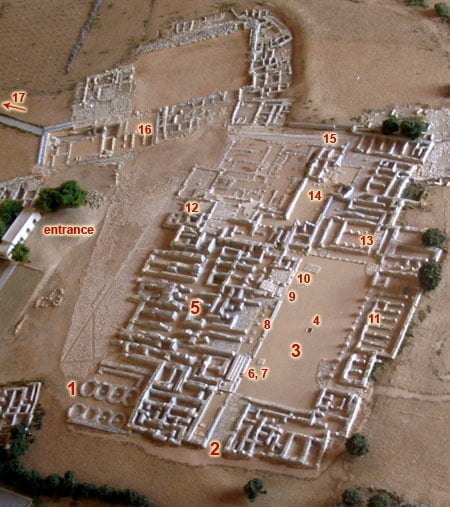
The entrance to the archaeological site of Malia
On entering, we find ourselves in a huge open space. The ruins of the Palace of Malia are in the background, and we will start our tour of the Minoan Palace by heading right (south).

Kouloures (No 1)
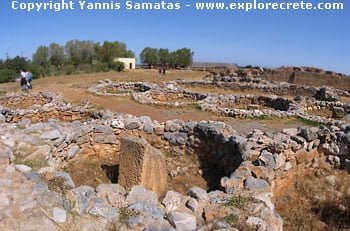
Just before we enter the main area of Malia Palace, we stop in the west paved court, whose southern end is blocked by a row of circular structures that archaeologists call “kouloures“.
These structures were covered with a roof supported by a central pillar and were used to store cereals; in other words, they were the granaries of the palace, vital for feeding the inhabitants.
South Entrance (2)
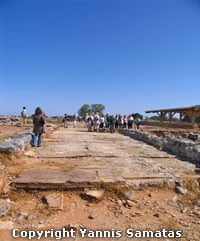
Passing through the South Entrance to the palace, which was more impressive than the North Entrance, we enter the Central Court.
Although the Palace of Malia was built over 3,000 years ago, the paving of the South Entrance is still preserved in good condition. If only modern construction works in Crete lasted that long…
Central Court (3)
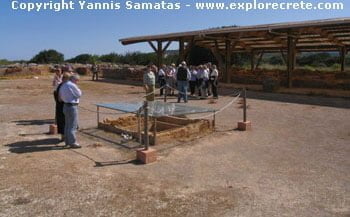
The Central Court of the Malia Palace is a large, open, rectangular space.
This had stoes (roofed colonnades) on the north and east sides and an altar in the centre.
Altar (4)
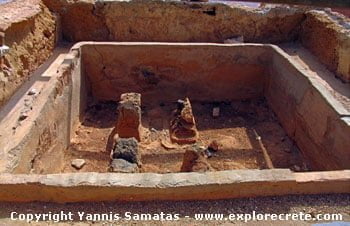
The altar in the Palace of Malia was protected by a special roof, is a square depression in the ground in which were set four plinths supporting a hearth.
The hearth was used for burning the butchered animal sacrifices.
Apart from animal sacrifices, the Central Court was used for other ceremonies, perhaps including – why not – the famous bull-vaulting.
West Wing (5)
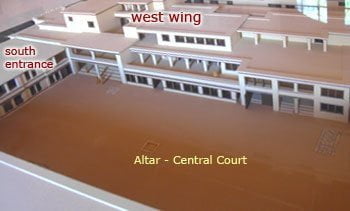
The West Wing of the Malia Palace is the most surprising part. It is the largest and most important area of the palace.
Built on two storeys, it contained shrines and official buildings as well as storerooms.
Staircase in the West Wing (6)
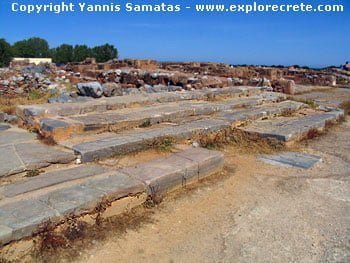
In the west wing of the Malia Palace, there is also an important staircase which may have served as a theatral area, where the famous Malia kernos was found.
Kernos of Malia (7)
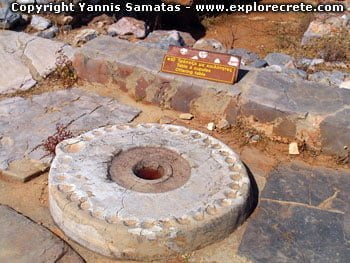
The famous kernos of Malia was discovered in the West Wing of the Palace.
This strange object is a round stone vessel 0.90 m. in diameter, with a large hollow in the centre and 34 smaller depressions around it.
You may wonder what it was used for. The place where it was found leads us to believe that it was a ritual offering vessel used in the rites of first fruits.
The worshippers placed small amounts of the first harvest, mainly seeds and fruit, in the small depressions as an offering to the deity, while the hollow in the centre was filled with liquid for a libation to ensure a good harvest.
Pillar Crypt (8)
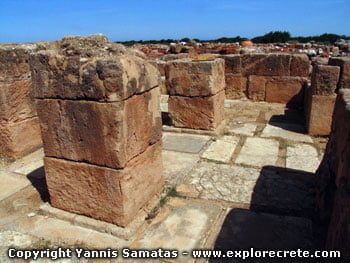
The Pillar Crypt with its antechamber is also an important area of the Malia Palace.
This is a crypt with two square pillars, used for cult purposes.
The Grand Staircase (9)
Right next to the Pillar Crypt there is a wide monumental staircase preserved in very good condition.
This is the Grand Staircase that led to the upper floor of the Palace.
The Loggia and the Central Court (10)

Immediately after the Grand Staircase you will see a small area (roofed in the past) on a higher level, which opens onto the Central Court. This is the Loggia, a ceremonial area for the ruler, dominating the court below.
In the panoramic image above, you can see the Loggia, the Grand Staircase, the Central Court and the altar, the East Magazines, the Pillar Crypt and the South Entrance of the Palace of Malia.

The steps behind the Loggia lead to the Treasury of the West Wing where many precious objects have been found, including a stone axe in the shape of a panther that formed the head of a sceptre, and a copper bracelet. In a nearby room was found a dagger and a wonderful long sword with a gilded shaft and a rock crystal pommel.
Although we cannot be certain what kind of ceremonies were held here, if we set our imagination free we might see the high priest of the palace or the king himself appear in the Loggia, bearing the sword and sceptre, to offer the gods a sacrifice on the altar as the crowd in the Central Court looks on.
East Storerooms (11)
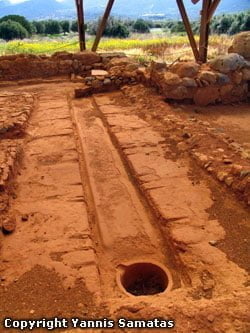
At the east entrance to the palace were the impressive storerooms for liquids, consisting of narrow cells opening onto a corridor.
Each cell had raised platforms with pithoi (large storage pots) on them. The most interesting thing is the mechanism of channels used to let the liquid run into a collection pot.
What for, you may ask? Well, if a pot was broken or some clumsy person spilt oil or wine on the floor, the liquid ran into the collection pot and wasn’t wasted. Clever, don’t you think?
Royal Apartments (12)
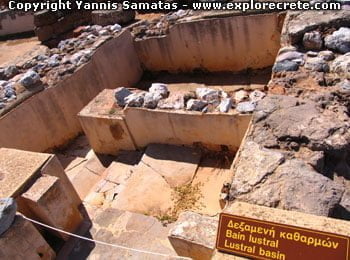
Behind the Treasury is the entrance to the Royal Apartments with polythyra (multiple doorways) and an atrium.
The first area we see are the ruins of the Queen’s Megaron, which may have communicated with the King’s Megaron.
Around them were other rooms, and a little further away we can still see an impressive lustral basin with six steps.
The Pillared Room and the Banquet Hall (13)
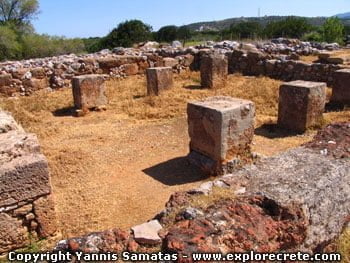
Behind the north stoa of the Central Court is a pillared room with an antechamber.
It is impressively spacious, with a ceiling supported by six pillars.
On the floor above was probably the banquet hall, while next to the pillared room were the kitchens where the meals served upstairs were cooked.
The Tower Court and the Mycenean Sanctuary (14)
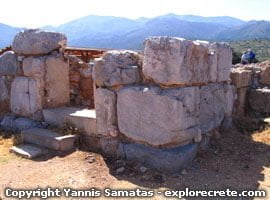
A paved corridor connects the Central to the North Court and the Tower Court, with workshops and storerooms in the surrounding area.
The Tower Court gets its name from a strong building of large blocks that looks like a tower.
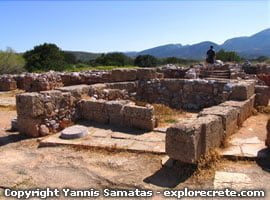
As we move on, we suddenly see a strangely-positioned oblique building. This is the Mycenean sanctuary, the only building constructed after the destruction of the second palace.
The North entrance and the Sea Road (15)
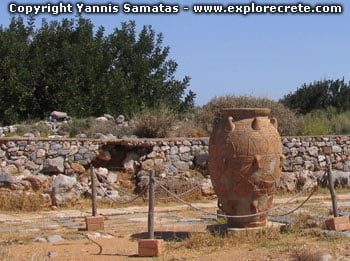
Now we reach the second official entrance to the Malia Palace, the North Entrance. This is at the end of a paved road which is still reasonably well preserved. We are truly lucky to be able to walk on the same paving-stones as the inhabitants of the palace, over 3000 years ago.
A wide paved road ended in the North Court. This was the Sea Road, leading from the sea to the palace. At the entrance are now set two large pithoi used for storing liquids, probably oil or wine. They are particularly large and decorated with raised spirals, patterns and ropes in relief.
The Minoan town and the Hypostyle Crypt (16)
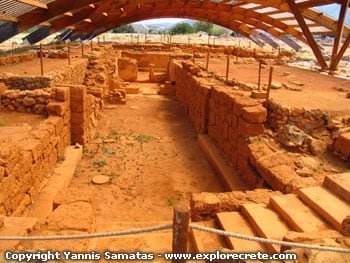
Around the Malia Palace lies the Minoan town, one of the most important in Crete. North of the West Court is the “Hypostyle Crypt“, a strange underground building with benches around the walls whose use is unknown.
According to the French archaeologist Van Effenterre, this is the Vouleuterion or Prytaneion (public banquet hall).
The central hall with its plaster walls was reached via a large staircase with many steps which started in the corridor and formed an angle.
Quartier M in Malia Palace (17)
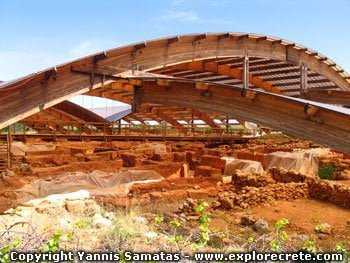
Various quarters and individual houses of the town have been excavated.
The most significant is Quartier Mu, the most important Protopalatial complex in Crete, covering an area of about 3,000 square metres. Excavations have brought to light various cult and official areas, storerooms and workshops.
Unfortunately Quartier Mu is currently closed to the public, and you can only glimpse it from the road running parallel to the archaeological site down to the beach.
The Necropolis of Chryssolakkos in Malia
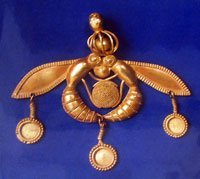
Near the north coast, NE of the palace, lies the excavated Necropolis of Chryssolakkos, dating from the first phase of the palace.
This is where the gold bees pendant masterpiece was found.
The finds from Malia are on display in the Heraklion Archaeological Museum, with a few in Agios Nikolaos Museum.
Open Hours, Free Admission Days & Tickets
© explorecrete.com All Rights Reserved. Reproduction or copying without permission is prohibited.

